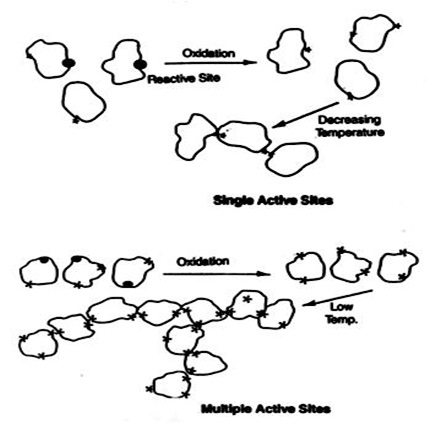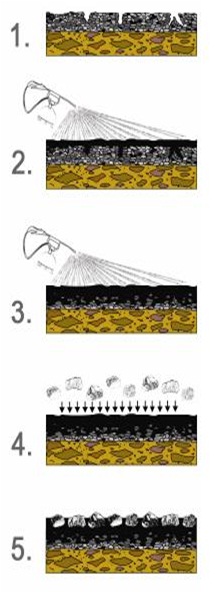





Published on Nov 30, 2023
The study investigated the aging properties of modified bitumen penetration grade PG 76-22 (binder). The aging was simulated using the rolling film oven (RTFOT) and pressure aging vessel (PAV) for short-term and long-term aging during production and lying of asphalt mixtures, though the actual time of long-term aging in the field varies depending on paving times and usage.
The empirical tests, which include penetration and softening points, were conducted to ascertain the binder consistency and also the viscosity of the binder was investigated before and after aging. The RTFOT was conducted at 1630C for 85min, and PAV for 20hrs. Results from the study indicated that aging resulted in oxidation of the bitumen with increase in the stiffness of the binder. It was observed that aging increased the viscosity, decreased the binder penetration and increased the softening point of the modified bitumen. It could be concluded that aging increases hardness, thereby decreasing the penetration and increasing the binder softening point and viscosity.
Aging in bitumen normally resulted from the weathering of the binder due to oxidation. The aging of bitumen is one of the principal factors causing the deterioration of asphalt concrete pavements. The aging modes of failures includes fatigue, thermal induce cracks, and raveling. In practice the actual time for short-term and long-term aging in construction sites varies and depends on hauling distances and period of pavement usage John, R., and W. David (2003). There are two basic mechanisms involved in binder aging, these include an irreversible process like chemical changes of the bitumen, consisting of oxidation of bitumen molecules, and loss of volatile components which subsequently has an impact on the rheological properties of the binders. The reversible process is the second mechanism termed as physical hardening; this involves the reorganization of the binder molecular structure, under specific conditions .Xiaohu, L. and U. Issacsson (2002).
Bitumen aging can be attributed to some factors these include the binder characteristics and it content in the mix, nature of aggregates and particle size distribution, air void content in the mix. Other factors include production related parameters such as temperature and time Edwards, Y. and U. Issacsson (2005). In this study the rolling thin film oven test (RTFOT) was used to simulate short-term aging and the pressure aging vessel (PAV). The RTFOT measures the effect of heat and air on a moving film of semi-solid asphaltic binder. The test temperature of 1630C and time for the RTFO test is 85 min expected to produce aging effects comparable to average site conditions Annual Book of ASTM Standards (2006)
The different binder samples A and B were simulated and artificially aged at 1630C for 85 mins using the rolling thin film oven test (RTFOT) in accordance with ASTM D 2872 (2006). For variability test, the same standard temperature for RTFOT was conducted at different additional time lags of 70 min and 100 min.
Using Pave The RTFOT residue were collected and placed in the PAV sample rack in accordance with ASTM D 6521 (2000). The PAV is preheated to the 100°C test temperature. When the PAV reaches within 2°C of the desired temperature, a pressure of 2070 kPa is applied using the valve on the air cylinder. After 20 hours, the air pressure is released slowly (over a period 8 – 10 min) using the bleed valve.
The amphoterics are the most reactive in terms of reactivity are capable of forming interlinked structures because they have more than one reactive site ( Fig).

Rejuvenation needs to be contact with the aged binder , ability to penetrate this binder. Emulsifier choice is needed.
Emulsion must coat and wet adhere to stone quickly
It must provide a Rejuvenation sealer, an enrichment emulsion or a chip sealing emulsion.

Bitumen emulsion is a liquid product in which a substantial amount of bitumen is suspended in a finely divided condition .in an aqueous medium and stabilized by means of one or more suitable materials
Effect of aging on bitumen performance was studied .The conclusion drawn from the study are
Properties of bitumen ductility ,viscosity and penetration varies with age
For different types of aging ,the properties are different
For storage ,penetration decreases 90% for 26 days and viscosity increased 77% for 26 days
For different sources of aging For UV aging 30% penetration for 9 hours and 17% in thermal aging. ductility varies 14% for UV and 44% for thermal aging.
The aging can be prevented by rejuvenation methods like . emulsion treatment and addition of filler ,Thus rejuvenating the bitumen ensures longer life to pavement
| Are you interested in this topic.Then mail to us immediately to get the full report.
email :- contactv2@gmail.com |